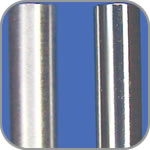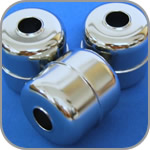Electropolishing
With Electropolishing, Passivating, Laser Marking and Laser Welding services all under one roof, NLE can save you the time and expense of using multiple vendors. Three shifts of operation result in unmatched capacity and rapid turn-around!
NLE specializes in electropolishing and passivating medical and light industrial stainless steel components. Electropolishing before/after laser welding or before laser marking is routinely performed. Passivating after laser marking is often a requirement on many components, including those for medical markets.
 The
photograph to the right shows the dramatic effect of electropolishing
on 304 SS tubing. At 10x magnification, processing marks are clearly
visible on the tube on the left (before EP). The tube on the right, after
being subjected to the electropolishing process, shows a much-improved
finish. Electropolishing is also extremely effective in removing oxidation
and discoloration of 17-4, 17-7 and 400 series SS components that have
been subjected to heat-treating.
The
photograph to the right shows the dramatic effect of electropolishing
on 304 SS tubing. At 10x magnification, processing marks are clearly
visible on the tube on the left (before EP). The tube on the right, after
being subjected to the electropolishing process, shows a much-improved
finish. Electropolishing is also extremely effective in removing oxidation
and discoloration of 17-4, 17-7 and 400 series SS components that have
been subjected to heat-treating.
 In addition to improving surface finish, electropolishing can be used
to debur components, or reduce the diameter or length of slightly oversized
parts. Since the EP process removes material, it is important to specify
any critical dimensions, and to allow for extra material so that these
dimensions are met after electropolishing. The 316L stainless steel floats
pictured to the right were laser welded by NLE, then electropolished
to remove any weld discoloration and to provide a mirror-like surface
finish.
In addition to improving surface finish, electropolishing can be used
to debur components, or reduce the diameter or length of slightly oversized
parts. Since the EP process removes material, it is important to specify
any critical dimensions, and to allow for extra material so that these
dimensions are met after electropolishing. The 316L stainless steel floats
pictured to the right were laser welded by NLE, then electropolished
to remove any weld discoloration and to provide a mirror-like surface
finish.
Passivating is performed per ASTM A967-01 (Standard Specification for Chemical Passivation Treatments for Stainless Steel Parts), and in accordance with ASTM A380-99 (Standard Practice for Cleaning, Descaling, and Passivation Of Stainless Steel Parts, Equipment, and Systems) guidelines. Northeast Laser also meets the specs for AMS 2700B (Passivation of Corrosion Resistant Steels). The AMS 2700 spec spells out protocols for Citric and Nitric passivaiton, very similar to ASTM 967. NLE uses the Citric Acid passivating process due to its proven effectiveness and reduced environmental impact compared to Nitric Acid solution. In addition, NLE has tested both 17-4ph and 300 series stainless to ASTM F1089-02 (Standard Test Method for Corrosion of Surgical Instruments) and successfully passed both the Boil Test and Copper Sulfate Corrosion test. NLE’s proprietary Corrosion Resistant Marking (on 17-4ph, 17-7ph and 300 series stainless steel) survives passivation and also passes ASTM F1089-02 both BEFORE and AFTER passivating.






